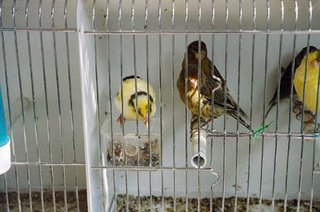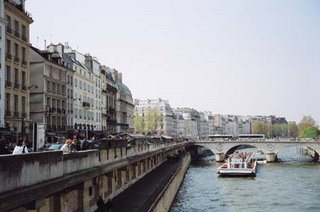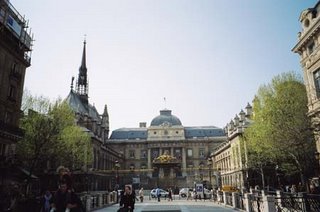Day 3, Nôtre Dame et Le Cathedral Ste. Chapelle
“Hey, pass those over!”

I pass the glasses. Nearby the chairs are still out, leftover from the morning mass. I sit. Nima studies the ceiling for several more minutes while I look back down, at the alter, at the cross-bar section of the nave, and at the people milling about. I want to talk to these people, find out why they would come all the way inside the church, unlike most people who just want to go to the top.
We walk around to the back, where there’s a roped off section, reserved for “silent prayer and reflection”. Nima goes behind the rope and takes a seat. I sit beside her. She closes her eyes. I close mine. After several seconds she taps me.
“What are those?” She points to funny-shaped chairs in front of us. The “seat” is low to the ground, and there are armrests where the back would normally go. The chairs face us, as if the are meant to point you away from the chapel.

“They’re kneelers,” I answer. As if to answer her question, a woman in her 40s approaches, teenage daughter in tow, and kneels. 
We sit for a few more seconds, Nima with her eyes closed and me watching the people, trying to guess at what they’re praying for. There’s a flyer on the chair next to me and I pick it up. It’s from a prayer Pope John Paul II gave in the late 1990s when he visited the cathedral to canonize a saint. It made me think of the people in Vatican City shouting “santo subito, santo subito” during his funeral a few days before. I translate it for her. She decides to keep it in her bag.
After a few more minutes she says she’s ready. We walk back to the front, trying to decide whether we should climb to the top or not. We rationalize that a) it costs more money, b) there are better high places to climb, c) the line is too long, and d) we have a long way to walk before the day is over. We go out the front door. 

Outside someone bumps me and I suddenly remember that there are pickpockets in the city, so I whisper something to Nima and we both tighten our grip on things. I do a quick check around my person and everything seems okay.
Near the hedges that separate Notre Dame from Ste Chappelle, a swarm of birds appears to be attacking an old man. He has a piece of bread, and dozens of sparrows hover and pick at it like hummingbirds. Near him several kids, sitting, start to hold up bread. For them, pidgeons show up instead of sparrows (630, 11A). We walk toward Ste. Chappelle, and Nima starts to talk about being tired and wanting to rest. There’s an open-air market nearby and we wander over. It’s a pet market--canaries, spice-finches, rosellas, and several Amazons chirp in cages too small for mice. Nima wants to buy one and so do I, but we figure we can’t get them back to our respective countries very easily. We walk through stalls of hamsters, chinchillas, small dogs, ladders, bells, and cedar shavings. The musk of the animal market is carried away by the breeze as we approach the Ministry building in front of Ste. Chappelle.

We go up Boulevard du Palais and follow the island street around to the back, to get into a queue in front of the smaller chapel. The admission price is 6,10E, and I give the ticket-counter lady 11,10E, hoping to get a 5E note back. She doesn’t give it to me, and I momentarily forget. When she’s finished with Nima, I tell her I gave her the 11,10E to get a 5 back, but I never got the 5. She questions me two times about exactly what I did, never switching to English, then calls her manager over. Then she pauses, her face changing expression. She starts nodding slowly, never breaking eye contact. Before her manager shows up, she reaches in front of her register drawer and picks up a 10E note. She holds it and looks at Nima, then at me.
“Je vous crois. Je crois que c’est correct.” She opens her drawer and gives me a 5, explaining that she thinks she remembers it, and that otherwise she’d have to have her boss count her drawer right now. Her smile is pleasant, and it seems genuine. I thank her and leave, glad to have slightly more battle-tested French credentials.
We go into the chapel, and Nima seems let down. It’s a long, narrow room, somewhat ornate but mostly just red and brown. I’m not particularly amazed by it, but then I know something about what’s upstairs. I guide Nima to the right and we go up the tiny spiral staircase. As we enter the upstairs area I hear the gasp again. Blue, red, yellow and green cover the floor in glows, like embers from a rainbow on fire. The source is a series of fifteen-foot tall stained-glass panels from one end of the room to the other, about 100 feet away from us in all. It’s a sunny day, just like Melissa’s mother told me it should be. I walk from the front to the back, studying the panels and the lead-work in between the panes. One pane is gone and it makes me want to cry. The figures are like cartoons, outlines in black and filled in with strong primary colors. I get out the binoculars and study the facial expressions, painted on in brownish paint over the flesh-toned glass. Nima finds a couple of seats and calls me over. As she’s calling, a loud “SHHHHHHH” comes from one corner of the room. She puts her hand over her mouth to keep from laughing. I sit next to her and hand her the glasses. She sighs long and heavy as she moves from one pane to the next. I watch the reactions on people’s faces and they come out of the stairway and see the place for the first time. We’re facing West, watching the sun as it moves slowly down from behind the glass. The pamphlet says there are over 6,300 square feet of stained glass in this chapel, and I have trouble believing that could be possible. I’ve attempted stained glass. How could a square mile of stained glass exist in the whole world? Especially when they didn’t have rotary sanders?!
They used to store holy relics here, including the crown of thorns, but they were all dispersed after the Revolution. No matter how unlikely I think it could be that they had the actual crown of thorns, it makes me sad. I look at the depictions of cruelty, of kindness, of the whole human experience played out in colored glass, and I’m amazed that we could be here. From two sides of the world, this girl and I are in a place somewhere in the middle, sitting in a building that’s 600 years old, and we’re about the same physically and mentally as those humans were then. Amazing.
Amazing.
I look over at Nima and she’s no longer studying the glass. Her eyes closed and her lip is trembling. A tear falls and she sniffles, then wipes her cheek. Her eyes snap open.
“You ready?” she asks.
“Yeah. I’m ready.”
She hesitates. “I just don’t know when I’m ever going to see anything like this ever again.”
“Yeah, me too.” I touch her shoulder and we walk out, this time to our right.
On the street, she wants to know what we should do next.
“Napoleon’s tomb?” I ask.
“Sure. Do you think we could pass the Musee d’Orsay on the way?”
“Yeah, but I don’t think we’d have time to do it justice.”
“Right. Offyago then, mate.”
We cross back to the left bank side of the Seine, to the Quai Malaquais. Book vendors are out now, with large metal boxes mounted onto the railing over the Seine, and we stop to browse. I look up the Seine, at the buildings that line her and the boats going under the Pont du Carrousel (630-10A). The books are almost all classics, Voltaire, Moliere, and Sartre, in what look like early editions. I don’t have any cash, however, and I probably have enough books.
We continue to walk, passing the Hotel des Monnaies, and several smart boutiques. Up ahead is the Musee d’Orsay, but we decide to turn left on r. de Beaune to follow the smell of crepes. The waiter is a bald young man, round-faced and my height. He motions us in without a word and acts like a mime with a gun to his head when I speak French to him. He sits us down and asks Nima what she wants. She wants champagne. I order a cafe au lait and a chocolate crepe with whipped creme. The waiter is clearly annoyed that I speak French and my lovely companion doesn’t. I weep for him.
The drinks come, and I clink my cafe au lait to her champagne. We toast to being in Paris, and to not really being alone. The crepe comes, and for someone who doesn’t like sweets, this girl goes a bit nuts. She doesn’t eat much overall, but she does enjoy it.
“Where did the chocolate come from?” she asks.
He looks at me, then back at her. I say nothing, suspecting he does speak enough English to have understood that.
“C’est le chocolat maison.”
“It’s the chocolate of the house,” I say. She smiles big at him. He points at his chin, and she begins to wipe. She gives me a dirty look for not having told her.
“There was nothing there,” I said. “He was fucking with you!”
She laughs.
When we ask for l’addition, he brings one for her and one for me. Hers says 0.00E. Mine says 17E. I hold out my Citibank card and he backs off, hands in the air. Again, mime in a stickup. Shit.
“That was a very nice thing he did,” I say. “But I’m afraid I don’t have any cash. I meant to stop at the--”
“No worries. I got it.” She throws the bills on the table. She's not the slightest bit annoyed. I attribute this to Australia, not to her being one-in-a-million, but I’ll probably never know.

Labels: paris


0 Comments:
Post a Comment
<< Home